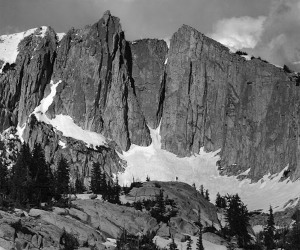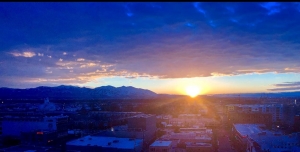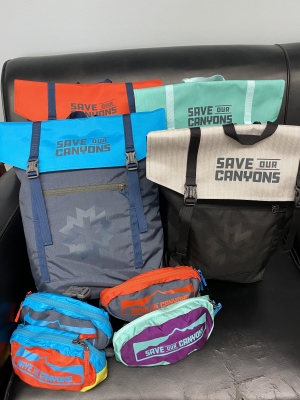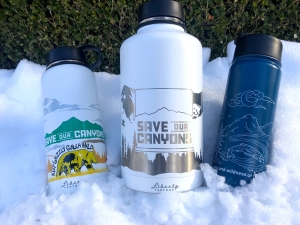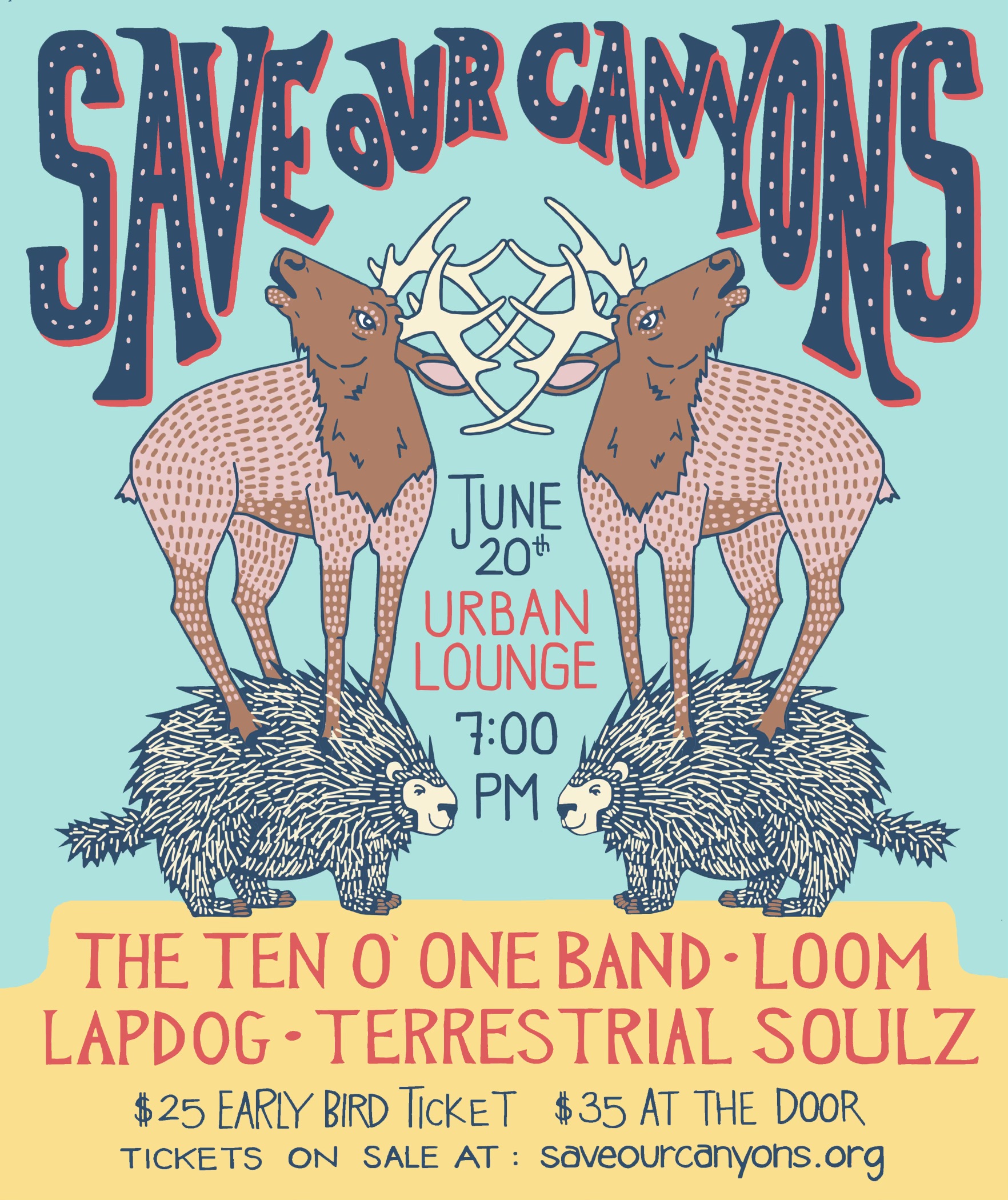Grace Tyler
Lone Peak Wilderness
The Lone Peak Wilderness is a 30,088-acre wilderness area located within the Uinta and the Wasatch-Cache National Forest in the U.S. state of Utah.
When Romantic Mountain Panoramas Become Sharp Memories
When Romantic Mountain Panoramas Become Sharp Memories
Written by the PanoramaKnife Team
The PanoramaKnife team in Switzerland has been successfully developing knives with mountain panoramas since 2012. In the interim, there are now over 80 different panoramas in Switzerland alone. But there are mountains and mountain lovers not just in this country, but also all around the world. For this reason, we decided in 2016 to expand our concept internationally, and went looking for the world’s most beautiful mountain panoramas.
One of the largest, most natural and beautiful mountain regions in the world is in the USA – the Rocky Mountains. For Marco and Hans-Peter, both passionate team members at PanoramaKnife, it was clear: the Rockies deserve a PanoramaKnife!
So, in February 2017 they set off on their first trip to the USA. Their PanoramaKnife adventure started in Denver and took them over Breckenridge, Vail and Aspen right across the Rocky Mountains. On March 1, 2017, they were driving from Prove towards Salt Lake City when they suddenly had to stop. No, not because of a traffic jam, but because what they saw made their PanoramaKnife hearts beat faster... What a sunset, what a breathtaking panorama!
This first contact with Utah and the Wasatch Mountains not only left a lasting impression, but also resulted in the very first USA PanoramaKnife!
It was not easy to find the first potential customers for the Wasatch Mountain PanoramaKnife. These unique knives were still completely unknown in the USA. But that didn’t bother them; they were absolutely inspired by this stunning mountain range, and that’s why Marco & Hans- Peter only had plan A: To produce this knife!
Today, 3 years later, we are happy to say that we have found some wonderful partners to sell our first “USA baby” in Utah. In the interim, more products have been added, and we are extremely happy about this success. In addition, we supported Save Our Canyons Lone Peak Celebration with a PanoramaKnife.
Environmental protection is a matter that is very close to our hearts, which is why we also support a variety of organizations in Switzerland that work to protect the natural environment. Save Our Canyons is the first organization outside Switzerland that we have committed ourselves to support. We want the wonderful, wild natural environment of the Wasatch Mountains to be preserved for many years to come!
Preserving Biodiversity
Wasatch Environmental Update for March 15, 2020
By John Worlock
Preserving Biodiversity - “30% by 2030”
What’s going on with our precious planet home, the Earth?
Sit down, and let’s talk.
You are aware of the existential threat of a changing climate, driven by the warming and acidifying effects of carbon dioxide in the atmosphere. You are acutely aware of the recent outbreak of the new coronavirus, called COVID-19. It’s dangerous and scary, but it probably doesn’t rise to the level of existential threat.
But there is another threat, to the Earth’s biodiversity: a million species are under threat of extinction. That number, a million, doesn’t impress us immediately, but we are encouraged to respect it when we learn that we are facing something akin to the Earth’s previous eras of species extinction.
OK, we can celebrate the extinction of the dinosaurs and their cohabitants, as that allowed the rise of the mammals, and eventually to humans, to us! Now there’s something to celebrate!
Today many of the species under current threat are the little wiggly and invisible guys who do the work of replenishing the earth (that’s a small-e earth), as well as the important insects that pollinate the plants that turn carbon dioxide into oxygen while building roots and leaves to feed the herbivorous animals. So, without our friendly worms and insects and spiders and so on, the whole web of life, so lovingly constructed over the millennia of evolution, can come crashing to a halt, and it’s bye-bye humans.
Don’t despair, however, for with a little bit of luck, the surviving species will start again the processes of reproduction and evolution.
Fortunately for us and our offspring, there are those who would like to halt this race to oblivion. For example, a new collaboration has arisen, led by National Geographic and the Wyss Campaign for Nature. They call it the Campaign for Nature. They call on world leaders to commit to the protection of 30% of the planet by 2030, along with proper management of the protected areas and finally, integration and respect for the lives of the indigenous people who coexist in harmony with so many of the threatened species.
Time’s up! Time for you to put this website in your browser. It’s campaignfornature dot org.
Hey! There’s still hope! 30% by 2030.
Welcome to Wasatch Week
A comprehensive plan for the Wasatch is perplexing to elected officials and they are saying, despite overwhelming consensus from this community that they can only do ONE thing for the Wasatch.
Utah Legislative Alert!
Wasatch Environmental Update for March 01, 2020
By John Worlock
Utah Legislative Alert!
It’s late February, the time of the year for the scary Utah Legislature to be in session. It’s scary, because the Legislature is prone to pass some really bad bills. One of their recent forays into the territory of serious error is the creation of the Utah Inland Port Authority, with the charter of inviting more diesel trains and more diesel busses into our Northwestern Neighborhood to whistle, snort and breathe exhaust; while these carriers’ burdens are shuffled around by massive diesel fork loaders. A very unpleasant addition to the neighborhood!
To add insult to injury, the Inland Port threatens to spread north of Interstate 80 into the edges of the Great Salt Lake that are home to many varieties of wildlife, including migrating species of birds. This is one of the reasons that Great Salt Lake Audubon has taken an especially strong interest in this year’s session of the Utah Legislature.
We go now to Great Salt Lake Audubon’s 2020 Legislative Update #3, with a current list of the bills that might impact the local environment, and their suggestions as to which of them deserve support or opposition. Surprisingly, many of the 2020 bills seem to be supportable.
Notable, however, is HB:347, introduced by a member of the Port Authority board. Although our new city mayor likes this bill, it is denounced by many opponents of the port as “window dressing.” GSL Audubon opposes it, and wants to make amendments, as it simply “encourages” sustainable development and the mitigation of environmental impacts, rather than making them mandatory. GSL Audubon suggests, with an exclamation point, that you urge your legislators to oppose HB347.
We recommend an educational visit to their website at greatsaltlakeaudubon dot org. In the search tab, write in “2020 Utah Legislature” and then click on the word ‘Home.” Scroll down to click on Legislative Update #3 and - voila! - there’s the information you need. Study it and make a plan to come back next week for Update #4, and so forth.
These are perilous times for the Utah environment, since the leaders of the legislature are full throttle in support of rampant growth and development.
Celebrating Wilderness - The Lone Peak Wilderness Party - 2020
Wasatch Environmental Update for February 16, 2020
By John Worlock
Celebrating Wilderness - The Lone Peak Wilderness Party - 2020
In these days of burgeoning population, Wilderness is no longer just a wild place with no human inhabitants. A Wilderness Area must be so designated by an act of Congress, after which that patch of the earth is to be protected from human habitation and exploitation.
We are wildly fortunate to have three such wilderness areas within sight and easy reach of the Salt Lake Valley. That’s what you see when you look at the Wasatch Range from anywhere in the valley: reading from right to left, the Lone Peak Wilderness, the Twin Peaks Wilderness, and the Mount Olympus Wilderness.
Save Our Canyons is working hard to get Congress to designate more Wilderness, but in the meantime we like to celebrate what we have already achieved.
Here comes the celebration, then, and you are invited to participate. It’s the 18th annual Lone Peak Wilderness Celebration, on Saturday, March 7th. Don’t rush around to get a pen and paper - you can get the details anytime on the website saveourcanyons.org. But put it in the back of your mind: Saturday, March 7th. The venue is a new one for us, at The Garden Place at This is the Place Heritage Center, on Sunnyside Avenue, out east of town on the road to Emigration Canyon.
As you might have guessed, this celebration is also a fundraiser for the work of Save Our Canyons, which is dedicated to keeping those nearby Wasatch Canyons wild and beautiful. It is sponsored by Kuhl, the outdoor clothing folks, and there will be food from Mazza, the local middle eastern restaurant, plus drinks galore and live music throughout the evening.
A silent auction will offer you a variety of bargains, including outdoor gear for your exploration of the Wasatch Canyons, art for decorating your home., an a night at the Opera!
Here is how to get your tickets: one, on the website by clicking here or two. call us at 801-363-7283.
Somehow just do it! Come out for Save Our Canyons’s Lone Peak Wilderness Celebration on Saturday March 7th.
Pivot RnD Backpacks and Fanny Packs
Pivot RnD, a Utah based gear development company stepped up their support this year by creating custom Save Our Canyons fanny packs and backpacks. Lead Designer CJ Whitaker reached out to SOC with the idea to get more mileage out of their annual donation to the organization by sourcing seconds from the materials they use in the development of their products to create these colorful, custom bags for your Urban and Backcountry needs.
We have found these backpacks to be the perfect carrying device to get you from your home and onto the UTA Ski Bus! This Pivot RnD backpack fits your ski helmet, gloves, goggles, buffs, favorite snack/drink, and the quintessential phone,keys, wallet.
Flashy and functional — we’re excited to have these bags to help us create more visibility for the organization, while raising funds that will go towards watershed protection, land use planning, recreation and transportation, public land protection, and ski area projects. All of backpacks and fanny packs are limited edition — so grab them while we have them!

Backpacks For Sale
Fanny Packs For Sale
Comments for Little Cottonwood EIS in 2019
Wasatch Environmental Update for December 15, 2019
By John Worlock
Comments for Little Cottonwood EIS in 2019
Here are some words from those preparing the Environmental Impact Statement for traffic in Little Cottonwood Canyon:
“The purpose of the EIS is not to increase or decrease the number of people in the canyon. Rather, the underlying purpose is to solve a transportation issue that affects local travel and recreation and tourism experiences.
The USDA Forest Service has determined that many areas on the Uinta-Wasatch-Cache National Forest may handle increased use, without significant resource impacts, while maintaining quality recreation experiences for visitors, and is therefore not presently considering limiting access.”
The comment period for the Little Cottonwood Environmental Impact Statement ended last Friday, December 13, but I thought you’d like to know what I told them about future traffic in Little Cottonwood Canyon. Here’s my statement:
“We are fortunate that there is a single public access point to the Little Cottonwood Canyon. We must begin to plan NOW for the near future when we will have to limit human access into the canyon. The Forest Service must begin the process of determining the ‘carrying capacity’ of the canyon's finite resources. Plunging ahead with plans to increase without limit the numbers of humans entering the canyon is insane. Zion and Yosemite National Parks learned this lesson long ago, and Arches is trying to learn it right now. We should begin to think about electronic links between the canyon's mouth and some of the crucial access points, such as trailheads, resort parking lots and avalanche barriers. There IS A LIMIT to the tourism that the canyon can entertain without serious degradation of its special, and precious, characteristics. More buses and fewer cars might be a satisfactory stop-gap solution, but eventually there must be limits to visitation. We are told of predicted Salt Lake Valley population increases of 50%. It should be obvious that Little Cottonwood Canyon cannot support similar increases in visitation.
So we need to begin to plan NOW to find the policies and practices that will be activated to preserve ‘the Wildness and the Beauty’ of Little Cottonwood Canyon.”
Just my own personal thoughts and hopes about the future of Little Cottonwood Canyon.
The National Environmental Policy Act at 50
Wasatch Environmental Update for December 8, 2019
By John Worlock
The National Environmental Policy Act at 50
When we celebrate the New Year this year on January First, we will also be celebrating the 50th anniversary of The National Environmental Policy Act, popularly known as NEPA. It was signed by President Nixon in the heady days of emerging environmental awareness. Nixon is quoted as suggesting that with NEPA, “America pays its debt to the past by reclaiming the purity of its air, its water and our living environment.”
Adam Sowards, an environmental historian, writing in High Country News, tells us of NEPA’s optimistic promises, but then gives us a sobering analysis of NEPA’s significance and its disappointing development over its five decades. It started with the belief that economic growth, environmental protection and human welfare could live in productive harmony.
But the procedural hurdle of the Environmental Impact Statement changed the ways federal agencies made their plans, requiring interdisciplinary studies and inviting public comment, in order to protect what the law calls “productive harmony.”
It didn’t take long for the courts to make the goals of NEPA flexible so that by 1989 agencies were no longer forbidden to undertake unwise activities, but only uninformed ones. Thus Environmental Impact Statements are required, and options laid out, but agencies don’t have to choose the best one.
And so it stands. Agencies must still go through the costly and time-consuming processes of preparing Environmental Impact Statements. They are still valuable, especially to environmentalists, as the discovery and explication of a region’s environmental characteristics is worthwhile just by itself.
But there are current attempts to gut the NEPA even further, for example, exempting the Forest Service from its rules. They can argue that, underfunded and understaffed as they are, they cannot afford the expense and the delay. The counter to that argument is that a nation that values its environment should provide the resources to protect it.
In closing we’ll quote NEPA’s opening section, which asserts that “ each person should enjoy a healthful environment, and each person has a responsibility to contribute to the preservation and enhancement of the environment.”
It’s time for us to get together and add to our environmental responsibilities, that of reviving the National Environmental Policy Act of 1970.
Let's Eliminate Single Use Products In The Wasatch.
Dozens of movies ranging from Wall-E to Blade Runner have depicted a population that has ruined all ecosystems and filled the world with trash – among other things. The levels of garbage that we produce has humans is overwhelming. A World Bank report projects that the amount of solid waste we generate on earth will double by the year 2025. If current trends continue, we are likely to go from 3.5 million tons to 6 million tons per day by that point. If that’s not bad enough, the figures predict that trash production will only keep growing for the foreseeable future.
Plastic, it turns out, is a much worse and more immediate problem for ocean life than climate change. It’s clogging waterways, leading to flooding in underdeveloped nations. It’s killing birds and fish who consume it, and much much more. Our abundance of trash isn’t just impacting oceans, but the Wasatch Mountains as well.
This past year during our Wilderness Stewardship Project we picked up three (42 gallon) bags of trash within Lone Peak Wilderness Designation Area and 21 (42 gallon) bags of trash during five highway clean-ups — averaging over 300 pounds of trash within the Wasatch Mountains that we removed! We are not the only ones within the community concerned about the levels of trash entering into the Wasatch. On average during the summer we are tagged in over 30 Instagram posts highlighting trash in our watershed, and over 67 posts encouraging people to practice the 7 Leave No Trace Principles.
Between water bottles, coffee cups, and beer cans explorers of the Wasatch are setup to create garbage unless they have the correct tools. Lucky for you, we have created a partnership with Liberty Works to produce custom Save Our Canyons 20oz, 32oz, and 64oz bottles to help reduce waste in the Wasatch and beyond! Eliminating single use products is our best defense against the problem of trash in the canyons. We have also integrated the 7 Leave No Trace Principles within our Wilderness Stewardship Project and SOCKids programs.
When purchasing one of the Save Our Canyons Liberty Karma bottles 10% will be donated back to Save Our Canyons to help protect your backcountry lines, crags, trails, and water quality.
Buy Yourself Something Nice Today
Next time you stop to get coffee before climbing up Little Cottonwood Canyon use our SOC coffee thermos. Or before you head out into Lone Peak Wilderness fill up our 32oz water bottle that not only helps to reduce waste, but also helps to show your support for #KeepingGrizzlyGulchWild. Then stop by your favorite hydration station to fill up our 64oz growler with your favorite brew.
We would like to give a big thank you to Liberty Works for contacting us about the partnership and for creating these amazing items. Let’s end 2019 by taking a strong stance against trash in the Wasatch Mountains.

